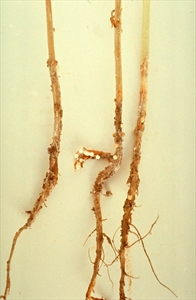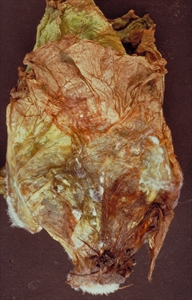- Worldwide distribution. On many vegetables, fruit and field crops. Important disease in sub-tropical countries.
- Cottony growth causes rots of roots, stems, leaves and fruits; also, damping–off. Black, survival bodies ('sclerotia') form, later producing a toadstool and liberating spores infecting dying leaves and flowers.
- Cultural countries: wide spacing; trellis; prune lower leaves/branches; crop rotation; soil sterilisation; add manures; mulch, do not harvest and pack in wet weather; plough in trash or collect and burn.
- Chemical control: seed treatments: thiram or captan; in the field: benzimidazole, strolbilurin or triazole fungicides.
Pacific Pests, Pathogens and Weeds - Online edition
Pacific Pests, Pathogens, Weeds & Pesticides
Lettuce Sclerotinia collar rot (129)
Cottony soft rot, Sclerotinia soft rot, collar rot, white mould, lettuce drop.
Sclerotinia sclerotiorum
AUTHOR Grahame Jackson
Information from (and Photo 1) Diseases of vegetable crops in Australia (2010). Editors, Denis Persley, et al.. CSIRO Publishing; and from CABI (2019) Sclerotinia sclerotiorum (cottony soft rot). Crop Protection Compendium. (https://www.cabi.org/cpc/datasheet/49124). Photos 2&3 Kohler F, et al. (1997) Diseases of cultivated crops in Pacific Island countries. South Pacific Commission. Pirie Printers Pty Limited, Canberra, Australia.
Produced with support from the Australian Centre for International Agricultural Research under project PC/2010/090: Strengthening integrated crop management research in the Pacific Islands in support of sustainable intensification of high-value crop production, implemented by the University of Queensland and the Secretariat of the Pacific Community.






